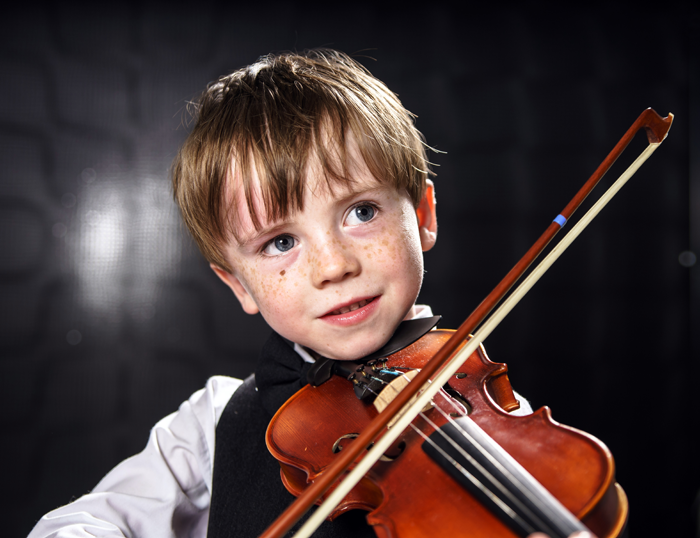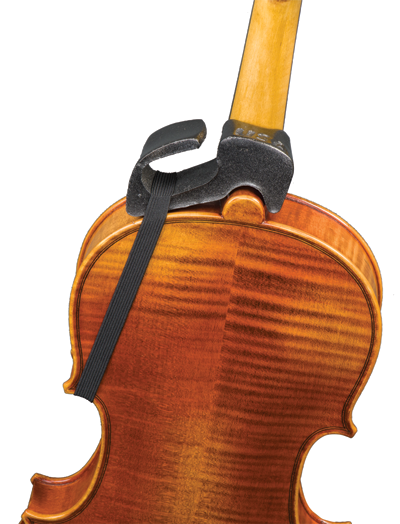
Most of us remember how tricky it was to learn to ride a bicycle. Falling down, scraping our knees, running into trees, or even the neighbor’s carefully trimmed hedges. Or maybe that memory is too far in the past for you, but you do remember teaching your son or daughter how to ride a bicycle. After privately chuckling to yourself the first few times they wobble and stutter, you probably encouraged them to try again. And if they were still having a really hard time, you probably suggested, “Let’s install some training wheels for you.” Sometimes a little extra help from training wheels makes things a lot easier. Similarly, it makes sense to use “training wheels” to help us learn to play an instrument, something that’s arguably far more difficult than learning to ride a bike.
Obviously we’re not going to bolt on wheels to your viola (although I’m sure there’s a viola joke in there somewhere). But there are two awesome teaching aids that can act as your student or your child’s “training wheels”: the Wrist Rascal and the Bowstopper. They’re great for beginners or for intermediate students who might benefit from a little extra help, especially for very young children who might need extra assistance developing fine motor control.
The Wrist Rascal
 Shout out to all the parents in our readership: Aren’t you tired of having to remind your child to practice with their wrist straight? Shout out to all the teachers in our readership: Aren’t you a little weary of seeing your student’s “pancake hand” in lessons every week, despite your best efforts to remind them and guide them to a proper position? We hear you. Students instinctually touch their left hand palm under the violin or viola’s neck to help them put their fingers on the string, but this negatively impacts their ability to play with more advanced technique later down the line. The Wrist Rascal is a learning aid that helps prevent the student’s left palm from touching the neck of the violin or viola. It also serves another purpose: it can be effective support for learning vibrato.
Shout out to all the parents in our readership: Aren’t you tired of having to remind your child to practice with their wrist straight? Shout out to all the teachers in our readership: Aren’t you a little weary of seeing your student’s “pancake hand” in lessons every week, despite your best efforts to remind them and guide them to a proper position? We hear you. Students instinctually touch their left hand palm under the violin or viola’s neck to help them put their fingers on the string, but this negatively impacts their ability to play with more advanced technique later down the line. The Wrist Rascal is a learning aid that helps prevent the student’s left palm from touching the neck of the violin or viola. It also serves another purpose: it can be effective support for learning vibrato.
It’s fortunate that this kind of “training wheel” exists now; this kind of thing wasn’t around when I was learning how to hold a violin! (I had to endure my teacher and my mom’s constant nagging about my left hand position—that was a different era, to say the least.) While the student’s teacher can correct them during lessons, a lot of parents are not entirely sure how to help their child at home. Of course, The Wrist Rascal won’t solve all your problems, but at least it’ll cut down on the number of debates you have with your child or student about keeping their wrist straight. The Wrist Rascal attaches to the violin or viola and prevents the student from touching their palm to the instrument’s neck. When used correctly, this useful tool will enable the student to develop muscle memory with the proper position. Plus, most kids love having a new toy on their instrument!
The Wrist Rascal is gaining in popularity among teachers and parents. It’s easy to see why. Most teachers and parents don’t mind using a “training wheel” to help their student or child have the best possible technique and setup, because the more solid a beginner’s foundation is, the easier it will be for them to play more advanced repertoire. Famous concert violinist James Ehnes even endorses use of the Wrist Rascal. He writes, “Wrist Rascals are a fantastic tool for developing proper hand position, perhaps the single most crucial element of a solid left-hand technique. Highly recommended!”
Now, go buy some training wheels… er, Wrist Rascals!
BowStopper
Great teaching aids often start with a resourceful teacher who keeps encountering the same problem. That’s what happened with the BowStopper.

Most teachers know that learning to use the bow properly can be extremely challenging. A big part of developing good bowing technique is learning bow distribution, which means playing in the different parts of the bow. In order to become a better player, one needs to carefully plan ahead which part of the bow they want to use for each note of the music. To aid in this goal, resourceful teachers often put tape on the wooden stick of the bow to help students learn how much bow to play with, but now there’s a smarter solution. Using the BowStopper instead of tape has a few key advantages:
- It teaches students how much bow to use by feel because the bow stopper gently bumps the string. As Regina Carter, famed jazz violinist, says about the BowStopper: “I recommend the BowStopper…because it places emphasis on learning by feeling rather than sight thus allowing the player to focus all attention on the music.”
- It does not harm the bow with sticky goo residue like tape does.
- It is easily movable to different parts of the bow because it snaps on and off.
For more information about BowStopper, check out these videos. Teachers will love the convenience of being able change where each BowStopper is very quickly. Students will learn much faster with the physical feedback they get from the BowStopper, since it also helps them maintain proper bowing while reading music—which is impossible with tape!




